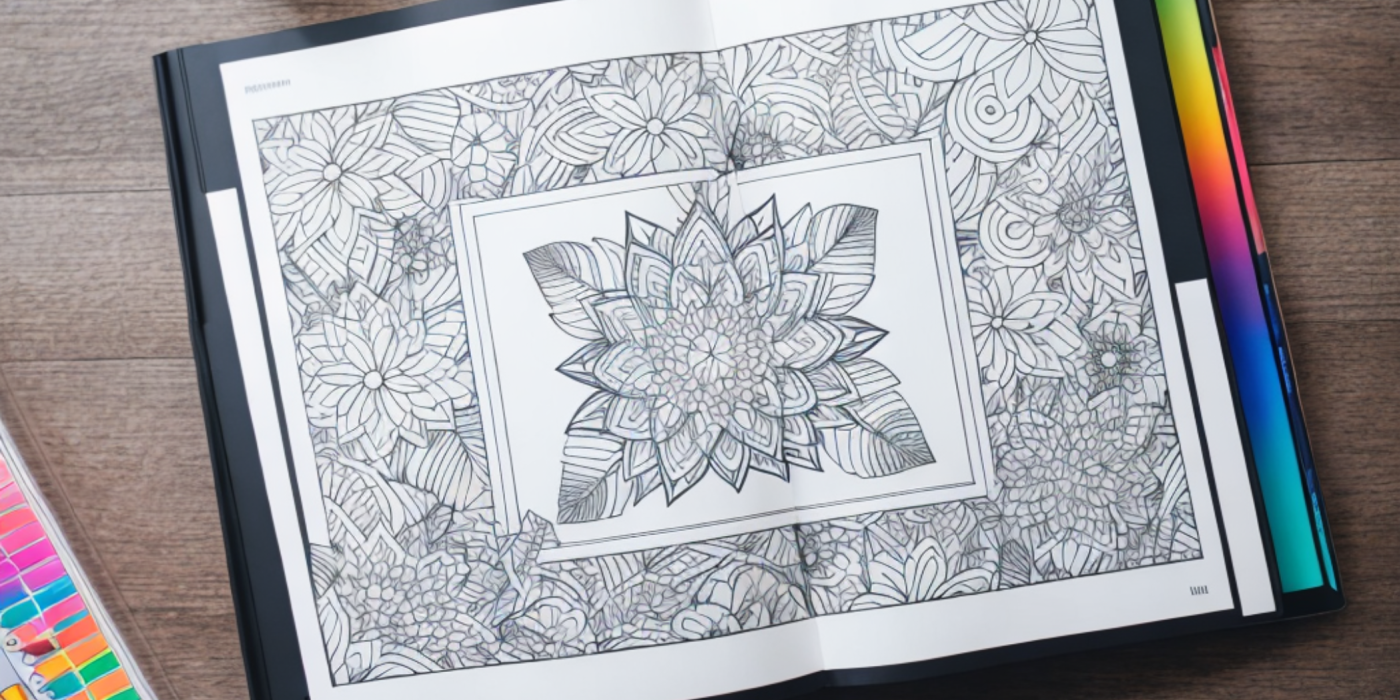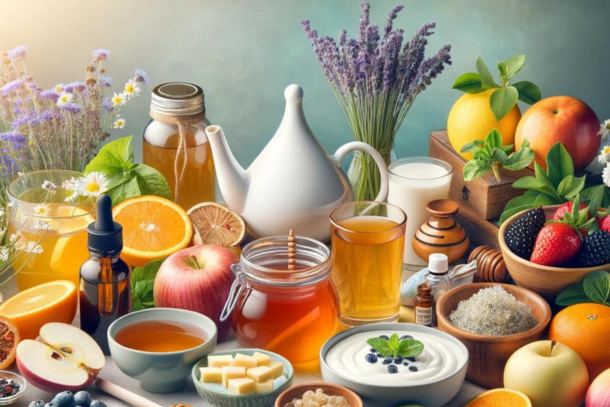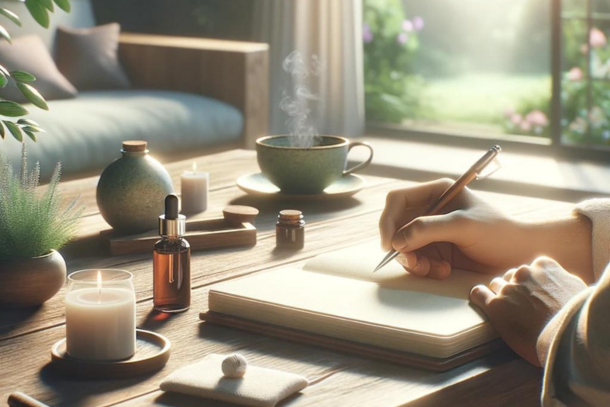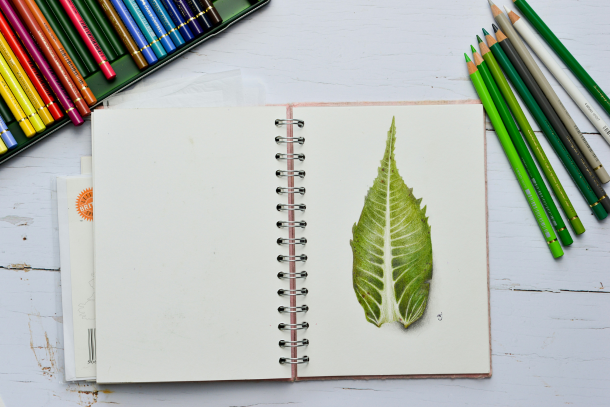10 Reasons Why Coloring Books Are So Good for You

If you've recently visited a bookshop or browsed an online bookstore, you've probably noticed a section dedicated to colouring books for adults. Once considered a pastime exclusively for children, adult colouring books have surged in popularity in recent years, appealing to individuals of all ages as a creative outlet and stress reliever.
Colouring Books: Not Just Child's Play
The rise of adult colouring books may seem like a sudden trend, but it is grounded in a long-standing appreciation for the benefits of creative expression. As our lives become increasingly dominated by digital screens and the incessant hustle and bustle of the modern world, many of us are turning to activities that allow us to unplug, unwind, and reconnect with our creativity.
Colouring books offer just that—a space for adults to lose themselves in the simple, meditative act of filling a page with colour. They provide a no-pressure platform for artistic exploration, where there are no wrong colours or mistakes, only opportunities for relaxation and self-expression.
Exploring the Many Benefits of Colouring Books
In this article, we'll delve into the benefits of colouring books for adults. We will discuss the tangible and intangible perks that this seemingly simple activity can bring. From stress relief and promotion of mindfulness to the enhancement of creativity and focus, the humble colouring book could be a surprising ally in our quest for well-being. So, grab your coloured pencils, and let's embark on this colourful journey together.
1. The Power of Colouring: Stress Relief
In our hectic, modern world, stress is an unwelcome companion for many. With the clamour of deadlines, responsibilities, and constant digital connection, our minds seldom get the chance to unwind. Enter the humble colouring book - a surprisingly potent tool in combating stress.
The Stress-Busting Power of Colouring
Colouring, as an activity, immerses you in the present moment. The act of selecting colours and filling in a design focuses your mind on the task at hand, leaving little room for stressful thoughts to intrude. This simple act of creating can transport you back to the carefree days of your childhood, providing a much-needed respite from the pressures of adult life.
When you engage in colouring, your brain enters a meditative state. This state of relaxation can help lower your heart rate and reduce the levels of the stress hormone, cortisol, in your body. Moreover, the rhythmic and repetitive nature of colouring has a soothing effect, acting as a natural stress-reliever.
Backing It Up: Research on Colouring and Stress Relief
The therapeutic benefits of colouring aren't just anecdotal. A study published in the journal "Art Therapy" found that just 20 minutes of colouring can significantly reduce symptoms of physical and emotional stress. In the experiment, participants who coloured in complex geometric patterns showed lower levels of stress and anxiety compared to a control group.
In a world that seems perpetually rushed and stressed, the quiet act of colouring can offer a valuable island of calm. So, grab those pencils and let the colours wash away your stress.
Reason 2: Promotes Mindfulness
Colouring: An Exercise in Mindful Living
Another potent advantage of diving into a colouring book is the encouragement of mindfulness. In our ever-bustling, always-on world, mindfulness can often take a backseat. However, the simple act of filling a page with colour can transport us into a state of focused calmness, engaging us entirely in the present moment.
As you glide your colouring pencil across the page, you're not just filling in an outline with colour; you're shifting your attention away from the chaos of daily life towards the simple, satisfying task at hand. The concerns of the past or worries about the future fade into the background as you immerse yourself fully in the ‘now’ – the precise shade of the colour, the gentle pressure of the pencil against the paper, and the slowly evolving artwork.
Backing Up with Psychology
This isn't just anecdotal; research supports this notion. A study by Curry and Kasser (2005) found that engaging in creative activities like colouring can induce a meditative state, reducing anxiety and boosting mindfulness. Similarly, a study published in the Journal of the American Art Therapy Association in 2016 revealed that just a brief stint of colouring—merely 20 minutes—can significantly reduce stress levels and promote mindfulness.
In essence, the humble colouring book could serve as a doorway into the world of mindfulness, providing a respite from life's hustle and bustle while honing our ability to stay present and focused.
3. Colouring Books: A Canvas for Creativity
Sparking and Nurturing Creative Thinking
There's an undeniable artistic allure that accompanies colouring. The act of choosing colours, and filling a blank page with vibrant hues, taps into our inherent creative thinking. Unlike other forms of art that may necessitate training or innate talent, colouring books offer a straightforward entry point into the world of creativity.
These books, adorned with intricate designs and patterns, serve as the perfect canvas to let one's imagination run wild. The colour palette becomes your toolbox, granting you the freedom to decide the mood, tone, and overall aesthetic of your creation. In this respect, colouring books go beyond their superficial appeal and become platforms for fostering creativity.
Crayons, Colouring, and Creativity: A Real-world Anecdote
To illustrate this benefit, let's consider a tale of Jane, a financial analyst by profession. Jane's work demands critical thinking and a methodical approach. Yet, she felt an unaddressed need to engage her creative side. Upon a friend's suggestion, she picked up a colouring book.
Initially, Jane found herself adhering to reality - grass was green, and the sky was blue. Over time, however, she began to experiment. She introduced surreal hues, painting the sky with strokes of pink and the trees in shades of blue. Jane discovered that her colouring book was more than a stress-reliever; it was an outlet for creative expression, unburdened by rules or judgements. This newfound hobby not only quenched her thirst for creativity but also provided fresh perspectives, enhancing her problem-solving skills at work.
So, colouring books, while seemingly simple, could indeed be the spark that lights the creative flame within us.
4. Why Colouring Boosts Your Focus and Concentration
Engaging in the simple, methodical task of colouring might seem like a trivial pastime, but it holds a secret weapon for our cognitive abilities. Indeed, this time-honoured activity has proven to be a potent enhancer of focus and concentration.
The Art of Paying Attention
When we delve into a colouring book, we are compelled to pay attention to intricate patterns and colour choices, pushing aside extraneous thoughts and distractions. This concentrated attention to detail fosters an increased level of focus. The simple act of selecting colours and filling in patterns or pictures can produce a state of absorption akin to a meditative state, helping us to develop a better attention span.
The Science of Concentration
There's solid science to back up these claims. A study by the American Art Therapy Association found that just 30 minutes of creative activities like colouring can significantly lower anxiety levels and increase mindfulness, leading to better concentration. Furthermore, psychologist Gloria Martínez Ayala asserts that colouring stimulates two regions of our brain, the prefrontal cortex, associated with decision-making and problem-solving, and the amygdala, which reduces stress. The simultaneous activation of these areas promotes a state of quietude that allows us to focus more efficiently.
So, next time you're feeling scatterbrained or struggle to concentrate, consider picking up a colouring book. You might find it to be an unexpectedly productive route to a more focused mind.
Reason 5: Fosters Better Hand-Eye Coordination
Engaging in a simple, yet focused activity such as colouring can significantly improve your fine motor skills and hand-eye coordination. This might seem like a skill only crucial during our early developmental years. However, maintaining good hand-eye coordination can benefit adults, too, particularly in our increasingly digital age where precision pointing and clicking are part of everyday life.
The Role of Colouring in Fine Motor Skill Development
Colouring requires a delicate balance of precision and control. The act of holding the colouring instrument, be it pencil, pen or crayon, requires a certain degree of strength and dexterity. Meanwhile, the task of filling a space with colour - staying within the lines, blending shades, and creating patterns - demands fine motor control. These actions together work to enhance our fine motor skills.
Hand-Eye Coordination Improvement through Colouring
Hand-eye coordination is another vital skill honed through colouring. As our eyes guide our hands to colour within the boundaries, the brain is actively involved in interpreting visual information and transforming it into coordinated motor action. Research suggests that this kind of regular, mindful practice can lead to improved hand-eye coordination over time.
So, the next time you pick up a colouring book, remember: you're not just indulging in a fun pastime. You're also fostering valuable skills that can contribute to your daily life activities.
Reason 6: A Palette for Personal Expression
One often underplayed advantage of colouring books is their potential as a tool for self-expression. Much like the strokes of a paintbrush or the scribbles of a pencil, the hues you choose and the intensity of your strokes can act as an emotive outlet, a silent language of your feelings and thoughts.
Colouring: An Emotive Conduit
Colouring has the unique ability to reflect our internal landscape on paper. With every coloured pencil or marker you pick up, you're making a choice that's innately personal. Perhaps you opt for warm, vibrant colours on a day filled with joy, or you might find yourself reaching for cooler, muted shades during moments of introspection. These decisions, whether conscious or not, make your colouring endeavour a personal journey, revealing layers of your emotional world one colour at a time.
In Practice: The Story of Julia
Take Julia, for instance, a 32-year-old Londoner who discovered the expressive power of colouring during the lockdown. Before, she viewed colouring books merely as a recreational pastime, but as she spent more time filling in intricate patterns, she began to notice a correlation between her mood and her colour choices. On days filled with anxiety, her pages would often be filled with stormy blues and greys. In contrast, happier days saw her pages burst into a symphony of sunshiny yellows and fiery oranges. Through colouring, Julia found an unexpected but welcome channel for her feelings, enhancing her emotional awareness.
So next time you pick up your colouring book and pencils, pay attention to the colours you select. You might just be surprised at what you discover about yourself.
7. Colouring Books as a Refuge of Relaxation
Colouring books aren't solely about fostering creativity or improving fine motor skills; they also offer a soothing sanctuary for relaxation. As you fill in a design with colours of your choice, the activity can induce a calming effect, allowing your mind to settle into a state of tranquillity.
Colouring, as an activity, is inherently rhythmic. The repeated motion of the pen or pencil against the paper can create a sensation akin to a rhythmic, soothing mantra. It can help to quieten a racing mind, letting worries and stresses of the day gradually recede into the background. Instead of being tangled in a web of thoughts, you're anchored in the present moment, focused on the simple task of adding colour to the page. This state of 'flow', where one is fully absorbed in a task, has been linked with increased happiness and relaxation.
Psychologists often underscore the value of such activities that promote 'flow'. A study published in the 'Art Therapy: Journal of the American Art Therapy Association' found that just 30 minutes of art-making, including colouring, can significantly reduce levels of anxiety and increase overall feelings of relaxation. Other research suggests that colouring can produce a meditative state, slowing heart rate and respiration, reducing blood pressure, and promoting a sense of deep relaxation.
In the hustle and bustle of our often hectic lives, grabbing a colouring book and some coloured pencils can be a simple yet powerful way to dial down stress levels and create a sense of calm. This tangible, easily accessible form of relaxation is just one more reason why colouring books are a valuable tool in promoting personal well-being.
8. Colouring: A Canvas for Positive Thinking
The Art of Optimism
Delving into the world of colouring isn't merely a pastime; it's a vibrant exercise in cultivating a positive mindset. As we carefully select hues, bring outlines to life, and gradually see a beautiful image taking shape, there's a natural sense of achievement and satisfaction that arises. This creative journey, where we're the architects of beauty, can do wonders for our mood, often leaving us feeling brighter and more optimistic.
Colouring, indeed, serves as a gentle reminder that we're capable of creating beauty - a belief that can then spill over into our everyday lives. When we acknowledge our ability to turn a plain page into a riot of colours and patterns, it can foster a more positive self-perception, helping us approach other aspects of life with a similar can-do attitude.
Evidence in Science
This connection between colouring and a sunnier outlook isn't purely anecdotal. Experts in the field of psychology have weighed in on the topic, linking the act of colouring to positive mental health outcomes. For instance, a study in the American Journal of Art Therapy found that individuals who engaged in colouring activities displayed significantly lower levels of depressive symptoms and anxiety.
The very act of choosing bright colours, focusing on the positive aspect of creating something beautiful, can trigger the release of dopamine, a neurotransmitter associated with feelings of happiness and pleasure. So, as it turns out, your colouring book isn't just a tool for creating art - it could very well be a key to fostering a more positive, optimistic outlook on life.
Reason 9: An Easy and Accessible Hobby
Colouring: A Hobby for Everyone, Anywhere
One of the most appealing aspects of colouring as a pastime is its remarkable accessibility. Unlike many hobbies that require substantial investment, colouring necessitates only a book and a set of colouring pencils or pens, making it an activity that's as easy on the wallet as it is on the mind. It's also an activity that requires no prior experience or particular artistic skill; simply pick up a pen and you're ready to go.
Colouring transcends the confines of location and time. Whether you're travelling on public transport, waiting at the doctor's surgery, or simply enjoying a quiet evening at home, a colouring book is a portable piece of tranquillity that fits comfortably into your day, wherever you may be.
Stories from the Canvas of Life
Take Sarah, for instance, a busy mum of two who's juggling work and family life. She began colouring during her commutes to work. What started as a casual distraction transformed into a cherished routine, allowing her to unwind and mentally prepare for the day ahead.
Or consider Tom, a retiree looking to fill his leisure time. Colouring offered him an affordable and enjoyable hobby that not only occupied his time but also improved his dexterity, a testament to the subtle physical benefits colouring can provide.
In sum, colouring stands as a hobby that can seamlessly weave itself into the fabric of your daily routine, offering a haven of tranquillity and creativity at your fingertips.
Reason 10: Fosters Social Interaction
Colouring books aren't just a solitary affair; they can also be a fantastic medium for social interaction. While you might primarily picture colouring as a peaceful, individual activity, there's much to be gained by bringing others into the mix.
A Social Canvas
At its core, colouring is a form of expression, and expression breeds conversation. This conversation doesn't have to be solely internal. Hosting a colouring session with friends or family can become a unique social event, breaking away from conventional gatherings. As everyone huddles over their artwork, they share ideas, compliment each other's work, and bond over the shared experience. It's a gentle, collaborative environment where individuals can engage in dialogue, share experiences and discuss their artwork.
The Power of Shared Creativity
Moreover, group colouring activities have been implemented in various settings, from schools to corporate team building to care homes. A study by researchers at Griffith University showed that shared creative activities like colouring can facilitate social bonding and cooperation. This shared creative time also encourages empathy and understanding, as individuals get a glimpse into each other's perspectives and creativity.
In conclusion, the social dimension of colouring may not be immediately evident, but it's a real and potent part of the colouring experience. The act of filling a page with colour can be a deeply personal journey, yet it also carries the potential to connect us with others. This reinforces the notion that colouring books aren't just good for you, but also for the connections and friendships that you hold dear.
Final Strokes: The Value of Colouring Books Summarised
Reflection on the Many Benefits of Colouring Books
As we reach the conclusion of our journey into the world of colouring books, it's clear that this simple activity boasts a rainbow of benefits. From acting as a potent stress buster and mindfulness promoter to sparking creativity, colouring books serve as a silent, supportive ally in our mental well-being. They enhance focus and hand-eye coordination, serve as an expressive outlet, provide a soothing escape, and promote positive thinking. Furthermore, their accessibility and potential for social interaction make them an ideal, low-barrier hobby for people of all ages.
Related to this article are the following:
I do hope you have enjoyed this article and hope that you will subscribe to my newsletter so you can get the latest information about all things naturally relaxing.
Stay in touch, join the Naturally Relaxing Newsletter
Newsletter Signup
Post Your Comments
or post as a guest
Be the first to comment.
Latest articles in Lifestyle

DIY Natural Beauty Treatments for Glowing Summer Skin

10 Natural Remedies to Combat Summer Allergies

How to Create a Relaxing Outdoor Space for Summer

Mindfulness Techniques to Reduce Stress in Your Daily Life

Hydration and Wellness: Natural Ways to Stay Hydrated in Summer






